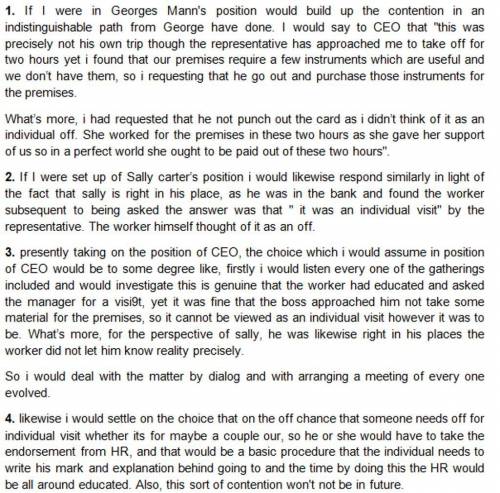
CASE: CHARTING A COURSE FOR CONFLICT RESOLUTION—"IT’S A POLICY" Background The setting is an 82-bed hospital located in a small city. One day an employee of the maintenance department asked the supervisor, George Mann, for an hour or two off to take care of some per-sonal business. Mann agreed, and he asked the employee to stop at the garden equipment dealer-ship and buy several small lawnmower parts that the department required. While transacting business at a local bank, the employee was seen by Sally Carter, the supervisor of both human resources and payroll, who was in the bank on hospital business. Carter asked the employee what he was doing there and was told the visit was personal. On returning to the hospital, Sally Carter examined the employee’s time card. The employee had not punched out to indicate when he had left the hospital. Carter noted the time the employee returned, and after the normal working day she marked the card to indicate an absence of 2 hours on personal business. Carter advised the chief executive officer (CEO), Jane Arnold, of what she had done, citing a long-standing policy (in their dusty, and some would say infrequently used, policy manual) requiring an employee to punch out when leaving the premises on personal busi-ness. The CEO agreed with Sally Carter’s action. Carter advised Mann of the action and stated that the employee would not be paid for the 2 hours he was gone. Mann was angry. He said he had told the employee not to punch out because he had asked him to pick up some parts on his trip; however, he conceded that the employee’s personal business was probably the greater part of the trip. Carter replied that Mann had no business doing what he had done and that it was his—Mann’s—poor management that had caused the employee to suffer. Mann appealed to the CEO to reopen the matter based on his claim that there was an important side to the story that she had not yet heard. Jane Arnold agreed to hear both managers state their position.
Instructions
1. In either paragraph form or as a list of points, develop the argument you would be advanc-ing if you were in George Mann’s position.
2. In similar fashion, thoroughly develop the argument you would advance if you were in Sally Carter’s position.
3. Assuming the position of the CEO, Jane Arnold, render a decision. Document your deci-sion in whatever detail may be necessary, complete with explanation of why you decided in this fashion.
4. Based on your responses to Questions 1 to 3, outline whatever steps—policy changes, guidelines, payroll requirements, or something else—you believe should be considered to minimize the chances of similar conflict in the future.

Answers: 1


Another question on Business

Business, 21.06.2019 22:30
True or false: on january 1, year one, the epstein corporation buys a plot of land with a four-story office building. the company believes the building is worth $1.9 million and has an estimated life of twenty years (with no anticipated residual value). the straight-line method is used. the land has an assessed value of $100,000. because the seller was interested in a quick sale, epstein was able to buy this land and building for $1.7 million. depreciation expense to be recognized in year one is $80,750.
Answers: 3

Business, 21.06.2019 22:30
An annuity that goes on indefinitely is called a perpetuity. the payments of a perpetuity constitute a/an series. the equation is: a stock with no maturity is an example of a perpetuity. quantitative problem: you own a security that provides an annual dividend of $170 forever. the security’s annual return is 9%. what is the present value of this security? round your answer to the nearest cent. $
Answers: 2

Business, 22.06.2019 20:10
As the inventor of hypertension medication, onesure pharmaceuticals (osp) inc. was able to reap the benefits of economies of scale due to a large consumer demand for the drug. even when competitors later developed similar drugs after the expiry of osp's patents, regular users did not want to switch because they were concerned about possible side effects. which of the following benefits does this scenario best illustrate? a. first-mover advantages b. social benefits c. network externalities d. fringe benefits
Answers: 3

Business, 22.06.2019 21:20
White truffles are a very prized and rare edible fungus that grow naturally in the countryside near alba, italy. suppose that it costs $200 per day to search for white truffles. on an average day, the total number of white truffles (t) found in alba is t = 20x − x 2 , where x is the number of people searching for white truffles on that day. white truffles can be sold for $100 each. if there is no regulation, how many more people will be searching for white truffles than the socially optimal number?
Answers: 1
You know the right answer?
CASE: CHARTING A COURSE FOR CONFLICT RESOLUTION—"IT’S A POLICY" Background The setting is an 82-bed...
Questions

Mathematics, 26.07.2021 18:20

Mathematics, 26.07.2021 18:20


Arts, 26.07.2021 18:20


Mathematics, 26.07.2021 18:20




Physics, 26.07.2021 18:20



Mathematics, 26.07.2021 18:20

History, 26.07.2021 18:20

Geography, 26.07.2021 18:20

Arts, 26.07.2021 18:20




Mathematics, 26.07.2021 18:20




